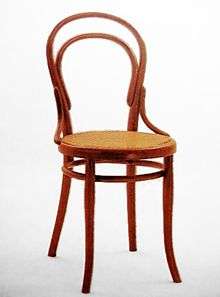No. 14 chair
| No. 14 Chair | |
 | |
| Designer : Michael Thonet | |
| Date : 1859 | |
| Country : Moravia then Austria | |
| Materials : Wood, Steam-bent Beechwood, 10 screws, and 2 nuts. | |
| Style/Tradition : Classic | |
| Dimensions: | |
| Colours : Light brown wood. | |
The No. 14 chair is the most famous chair made by the Thonet chair company. Also known as the bistro chair, it was designed by Michael Thonet and introduced in 1859.[1] It is made using a unique steam-bending technology, known as bentwood, that required years to perfect. With its affordable price and simple design, it became one of the best-selling chairs ever made. Some 50 million No. 14s were sold between 1859 and 1930, and millions more have been sold since.[2]
Thonet's No. 14 was made of six pieces of steam-bent wood, ten screws, and two nuts. The wooden parts were made by heating beechwood slats to 100 °C (212 °F), pressing them into curved cast-iron moulds, and then drying them at around 70 °C (158 °F) for 20 hours.[3] The chairs could be mass-produced by unskilled workers and disassembled to save space during transportation, an idea similar to flat pack IKEA furniture.
Later chairs, as illustrated here, were made of eight pieces of wood: two diagonal braces were added between the seat and back, to strengthen this hard-worked joint.
The design was a response to a requirement for cafe-style chairs. The seat was often made of woven cane or palm, because the holes in the seat would let spilt liquid drain off the chair.
Chair No 14, today known as 214, is still produced by Thonet.[4]
Design classic
The No. 14 chair is widely regarded as a design classic. It earned a gold medal when it was shown at the 1867 World Exposition in Paris. It has been praised by many designers and architects, including Le Corbusier, who said "Never was a better and more elegant design and a more precisely crafted and practical item created." [3]
Redesign
In 2009, the chair was redesigned by James Irvine, an English designer, and retailed from Muji, a Japanese company. Roland Ohnacker, managing director of Thonet, stated that the aim was "to help 18 to 35 year-olds enter the Thonet brand world." [5]
References
- ↑ "A Brief History of Sleek Seats". Wall Street Journal. June 15, 2012. Retrieved 16 June 2012.
- ↑ Alice Rawsthorn (7 November 2008). "No. 14: The chair that has seated millions". International Herald Tribune. Archived from the original on 2008-11-13. Retrieved 7 January 2009.
- 1 2 Bettina Becker (June 2007). "Thonet - A modern design institution". Goethe-Institut. Archived from the original on 2008-09-22. Retrieved 7 January 2009.
- ↑ "214 Design Gebrüder Thonet, 1859". Thonet.
- ↑ ""manufactured by Thonet" – Muji presents a new collection". Thonet. November 2008. Archived from the original on 2010-11-24.